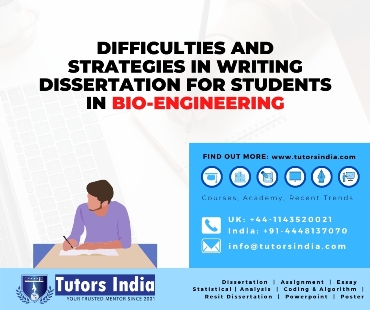Difficulties and Strategies in Writing Dissertation for Students in Bio-Engineering
In-Brief
- To make a good dissertation bioengineering, the writing process must be started earlier with an outline that is further developed to form content and selecting an appropriate journal.
- Values in the dissertation report must not be replicated and must not ignore negative results if obtained.

Introduction
Dissertation writing in Biomedical Engineering aims in analyzing or solving problems in the biomedical field by applying some engineering methods. The bioengineering dissertation writing offers a chance for the postgraduate students to apply engineering principles that have been learned previously and also to apply these techniques to solve the problems innovatively such as the design development, method, and/or the analysis of a hypothesis. Bioengineering thesis projects are more complex, and open‐ended problems that promote students to be more creative in the achievement, investigation, and analysis of results. The dissertation allows students to devise problems in engineering terms, handle an engineering project, and discover solutions by applying engineering techniques.
Dissertation structure
The structure of the dissertation includes an introductory chapter, a chapter that carries out the research process, and an ending chapter that summarizes everything together.
Before starting to write a dissertation, it is essential to make an outline of the topic. After making an outline, figures and tables must be included in it to frame the results. Develop the outline with consecutively more information, and then this information must be replaced with sentences and paragraphs, and then finally the written document will form a proper shape. While developing an outline, verify it with the adviser/professor to ensure that the research is on track. To write a paper, the result section must be framed first. Then frame the Discussion section in relation to the Results. Then the Introduction part must be written and linked to the Discussion.
Strategies to Write Bioengineering Dissertation
1. Early Beginning is Beneficial
Dissertation writing in Biomedical is a learning process, and students acquire this expertise through experience. Therefore, it is recommended to start the writing process as early as possible. The first strategy in thesis writing is to carry out attentive and extensive reading in order to get an outline of the published literature, to recognize the style and structure of research articles. It is a significant process in dissertation writing and many students do not devote sufficient time to go through enough articles. Once, the student has done enough research in reviewing literatures, the next step is to examine the utilities of software tools and writing guides that are available.
Then it is time to prepare for one’s own dissertation. The most significant part is making an outline and preparing a draft for the research article as soon as possible. An exhaustive outline assists the writing process and the outline of a project is the key element for its success. Structural templates assist the process of outlining the thesis.
2. Working in Teams
Writing a dissertation as a group is advantageous as it enhances both efficiency and output. Writing a dissertation as a group not only enhances the outlook to aims, opinions, and conclusions, but it is the best strategy to draw necessary feedback. Obtaining feedback from peers facilitates efficient writing. Feedback assists to identify discrepancies, improper text structures, indistinct messages, rambling text parts, errors in content, and eventually leads to enhanced text quality. Additionally, feedback assists students to identify their strengths and weaknesses.
3. Selecting a Journal
It is recommended to choose the target journal as early as possible in the writing process. The journal must be selected before preparing the rough draft of the research project. Therefore, writing a dissertation that has been intended towards a specific journal not only facilitates students in choosing the accurate content and method but also accumulates time and ignores unnecessary modifications and standstills during the preparation of the final draft of the dissertation. The additional criterion to be considered for selecting the right journal are open access options, the informal reputation of the journal, the cost of publication, copyright policies, and peer review systems.

4. Nurturing the Dissertation
The dissertation must undergo internal reviewing among classmates, in order to cherish its content and enhance the style. At this stage, students are advised to present precise content in their dissertation. The best way to attain lucidity and link within the dissertation is to have clear and precise paragraphs. The main purpose of the topic should be stated at the beginning of the paragraph. The second important aspect is the accuracy of the content that needs to be checked. In order to achieve accuracy in the content, it is significant to check the data, logic of each line, and their references. Third, the focus is to be made on language issues such as spelling, grammar, and punctuation. There is software available for grammar and spellchecking that facilitates avoiding errors and various writing guides offer tips for writing a better dissertation. 3
Challenges in Bioengineering Dissertation
In the bioengineering field, new guidelines emerge, and old ones are always revised, and a scientific paper writer has to stay up to date. Bioengineering students must be updated in the knowledge of guidelines. There are many difficulties faced in biomedical dissertation. They are:
1. Values must not be reiterated from a table or figure. It should only be the key result that each conveys.
2. The same data must not be included in both the table and figure as this is considered unnecessary and can save space and energy. Choose for a best and precise format that provides an accurate result.
3. Raw data values must not be reported, as they can be summarized as means, percents, etc.
4. Statistical test summaries are usually reported in combination with the biological results they support. Results must always be reported in reference to the statistical conclusion that supports the result.
5. Report negative results: Students mostly do not get the expected results. They think that their hypothesis was inaccurate and needs to be rechecked. So, they become stumbled against something unanticipated that demands further research. In some cases, even though the derived results do not support the hypothesis, it may be of significance to others. Students must be confident enough about their findings. If the research is carried out well, the results will be precise and need analysis.
Conclusion
The most advanced field in science and technology is considered as Bioengineering/Biomedical Engineering. It has prompted the development in the field of medicine and biology. Biomedical engineering involves utilizing engineering techniques in solving medical and biological problems to enhance the quality of life. This paper describes the strategy of writing a dissertation in technology and engineering, and also discusses the objectives and challenges of biomedical engineering thesis writing.
Future scope
As the field of Bioengineering/Biomedical Engineering is emerging, it is predicted that research in this field will continue to propagate for the next decades worldwide, particularly in developing countries. It is projected that the academic curriculum in this field will go through further alterations, and perhaps evolutions, sloping towards most favorable objectives, which would promote more relations between higher learning institutions and organizations thereby promoting the quality of healthcare. It further advances knowledge in medicine, biology, and engineering.
References
1. Robert Nordon, 2019, Faculty of Engineering Graduate School of Biomedical Engineering
2. Albert A. Einstein, 2019, Bioengineering Graduate Student Handbook
3. Vikash Singh, Philipp Mayer, 2020, Scientific Writing: Strategies and Tools for Students and Advisors
4. Lewiston, 2019, How to Write a Paper in Scientific Journal Style and Format
5. Dušanka Bošković, Almir Badnjević, 2018, Opportunities and Challenges in Biomedical Engineering Education
6. Ziad O. Abu-Faraj, 2019, Handbook of Research on Biomedical Engineering Education and Advanced Bioengineering Learning: Interdisciplinary Concepts

 Next Post
Next Post